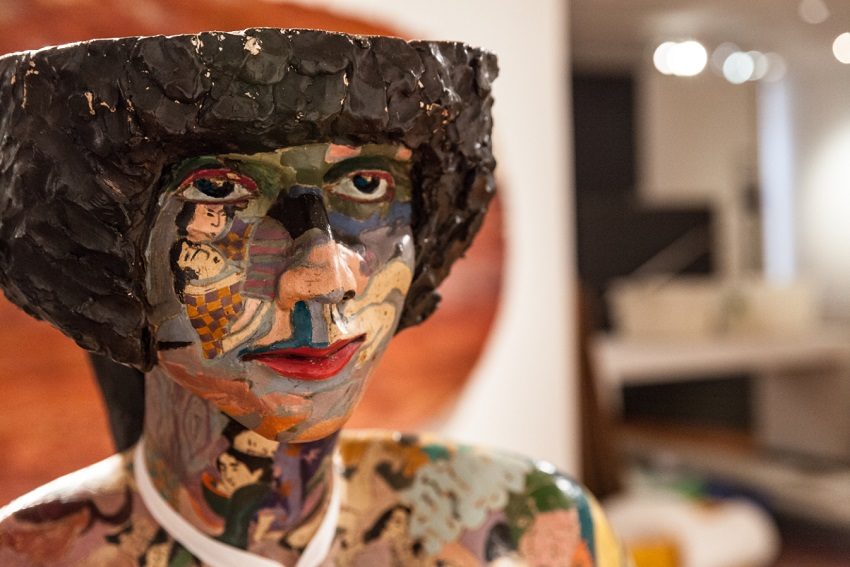Identity Heft: Redefining Australian Art

The Art Gallery of South Australia’s new hang examines Australian identity.
When Nick Mitzevich and Lisa Slade began working at the Art Gallery of South Australia (AGSA) in 2010, they realised that Adelaide’s sense of complacency needed to be challenged.
“We had visitors who had come once for a school excursion, and then 30 years later found the same things in the same places,” Slade says. What’s the point of having a collection of over 40,000 works if we insist on clinging to our favourites? So began the process of rehanging the Australian art galleries.

Margaret Dodd, Australia, 1941, F.J. Holden pretending to be an Australian native Porcupine, 1982
Rehanging the gallery isn’t a simple ‘switcheroo’ exercise. Once a new work is introduced, it changes the context of the pieces it hangs alongside. To properly rehang the gallery, the spaces needed to be reconceptualised: what do visitors need AGSA to provide? Which question is the gallery uniquely positioned to pose or answer? How best are those answers displayed?
“When we think of [AGSA’s] audiences, some are making their first visit to Adelaide, or their first to Australia, so they walk in here to try to get a bead on what this thing is called Australia, what is this place?” Slade says. “How do you extract a local narrative from a national history, at a time when we’re thinking post-nationally? That’s a really interesting conundrum for a curator, and for art historians and for audiences.”
 Installation view Gallery 6, Art Gallery of South Australia, Adelaide, 2017
Installation view Gallery 6, Art Gallery of South Australia, Adelaide, 2017
Solving the conundrum is no small feat. The challenge is to group works in such a way that they articulate questions and answers simply by existing in each other’s presence. This process of reimagining the gallery’s shape and function, not to mention selecting works to spotlight, is lengthy and exhausting.
“Hanging a gallery collection is like painting the Harbour Bridge,” Slade says. “You get to the end, and you have to start at the other again. Rehanging a collection takes so long, and requires such constant rethinking of the canon. We’re in the business of trying to unpack and rethink through those art historical tropes.”
A typical public institution gallery is one that displays works in silos. These galleries are influenced by their role as educational aid: each room becomes a teaching tool for distinct art forms, eras or artists. This blocking technique presents discrete stories about art in a vacuum. AGSA’s approach defies this.
 Lisa Slade, Assistant Director, Artistic Programs, Art Gallery of South Australia
Lisa Slade, Assistant Director, Artistic Programs, Art Gallery of South Australia
The new galleries are all about narrative links that pull history, ideas and artists together. The modern art gallery, for instance, has had a deeply considered revamp, and the works now play off each other like a game of Six Degrees of Separation.
“We’ve called [this gallery] Looking Out and Looking Within for a reason,” Slade says. “We’re not trying to be parochial, but what are the local stories around Australian identity and modernism — how do they link up with national stories and this international context? It’s a two-way street. I think it’s easy for us to overthink about Australian artists getting ideas from outside, or European artists coming in and changing what we do, but it’s a much more fertile interchange than history would suggest.”
Stand in front of Sydney Ball’s Banyon Wall, a slice of New York City created in Collinswood, South Australia, and look out over 60 years of connections. There’s Genus 1, No 2 a Mobius-inspired piece by Margaret Worth, Ball’s first wife. Opposite Worth’s work is Andy Warhol’s portrait of Henry Gillespie, next to Howard Arkley’s mocking homage to Australian suburbia. In the same room, one of Arkley’s chairs, and Janet Dawson’s tabletop — domestic objects as art, is there anything more quintessentially suburban?

Installation view Gallery 6, Art Gallery of South Australia, Adelaide, 2017
Beyond that, a vividly coloured camouflage mural covers one wall; an archway cuts through the middle, and through that opening peer Sidney Nolan’s heads. The camouflage, by Kamilaroi artist Reko Rennie, riffs on ideas of visibility and invisibility. Facing the camouflage is one of Gordon Bennett’s John Citizen pieces, works that rebelled against labels, challenged perceptions of Indigenous art, explored anonymity and rejected the creation by others of the artist’s identity.
The complexity of these galleries cannot be overstated. To create this cohesive display of Australian art, the curators have drawn lines across geographical, conceptual and temporal boundaries. By combining decorative arts — furniture, fashion — with figurative painting and abstraction, the gallery becomes a three-dimensional capture of art, in all its forms, by all its practitioners. AGSA understands that it isn’t enough for galleries to say, ‘This artist was born in Australia, so their piece will go in the Australian wing, alongside similar works.’

Installation view Gallery 6, Art Gallery of South Australia, Adelaide, 2017
“The world in Australia and Australia in the world is the sub-theme throughout,” Slade says. “The questions we’ve been asking as we’ve rehung the gallery are: What makes an Australian artist in a postnational world? Does nationality matter for art? How do we honour the local and the global?”
Art Gallery of South Australia
New galleries open from Friday, September 1
artgallery.sa.gov.au
Header image: Bert Flugelman, Australia, 1923 – 2013, Tattooed lady, 1974
Photography: Sia Duff